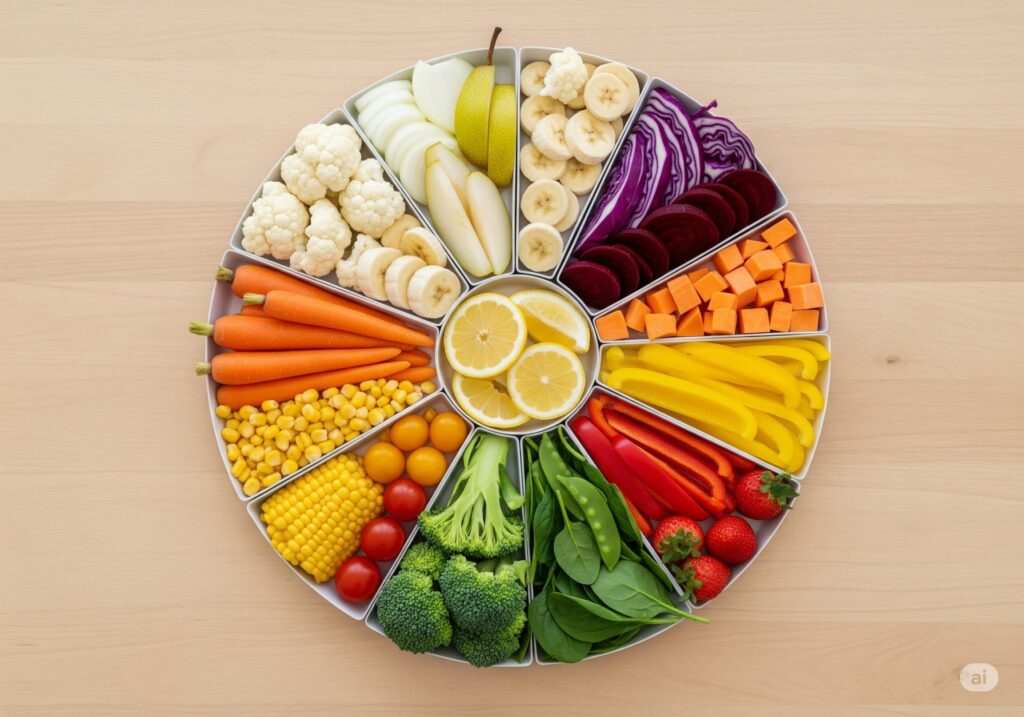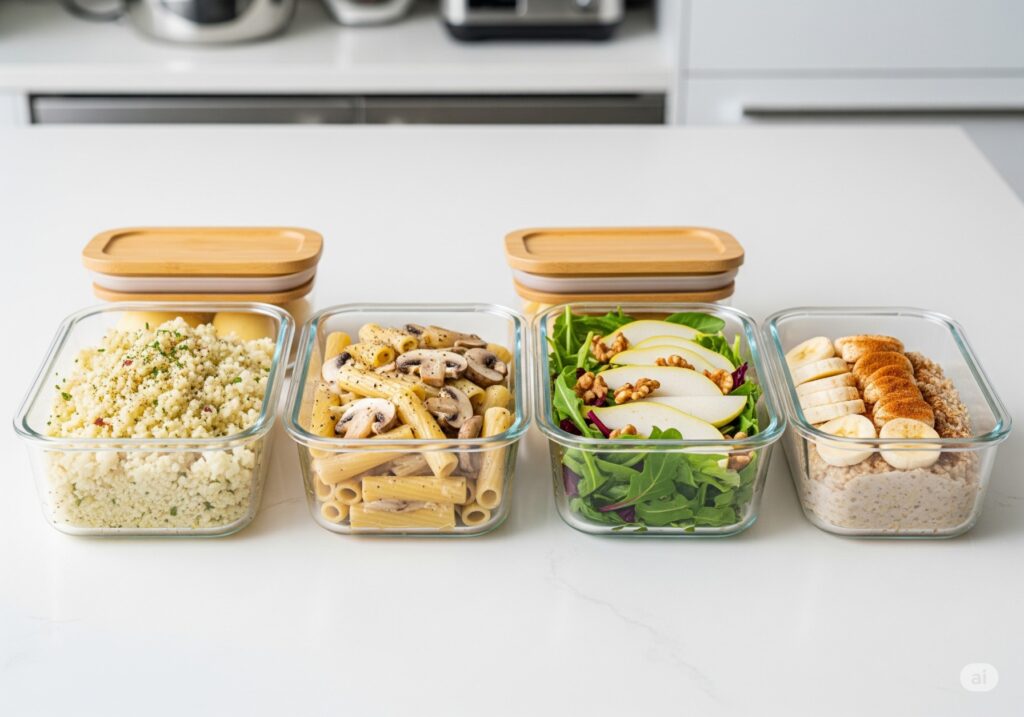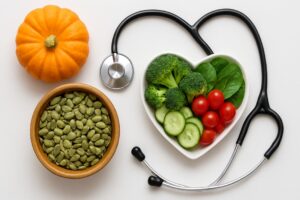
A rustic basket filled with white-fleshed fruits and vegetables for cancer prevention
New research links white-fleshed fruits and vegetables to a 36% lower gastrointestinal cancer risk. Discover which foods are beneficial and how much to consume.
Eating These Foods May Lower Gastrointestinal Cancer Risk by 36%, New Study Suggests
Gastrointestinal (GI) cancers include cancers of the stomach, colon, rectum, liver, pancreas, and more. Diet plays a major role. And now, a new analysis points to a surprising hero: white-fleshed fruits and vegetables. According to the study, people who eat the most of these foods may have a 36% lower risk of GI cancers. That is a big number. But what exactly counts as “white-fleshed”? And how much should you aim for? Let’s break it down in simple steps. ScienceDirect, EatingWell, AOL
What the new research found on white-fleshed fruits and vegetables

The analysis, published in a peer-reviewed nutrition journal, grouped produce by color families and looked at GI cancer outcomes. It found that people in the highest intake group for white fruits and vegetables—think cauliflower, onions, garlic, mushrooms, pears, bananas—had a 36% lower risk compared with those who ate the least. In addition, red and purple vegetables were tied to up to a 32% lower risk. That is encouraging for anyone who loves a colorful plate. ScienceDirect, EatingWell, Yahoo Health
For a clear, reader-friendly recap, see coverage from EatingWell and Yahoo Health:
- EatingWell summary
- Yahoo Health recap
These pieces explain the color group findings in everyday language. But the core statistics trace back to the study itself. Abstract on ScienceDirect. EatingWell, Yahoo Health, ScienceDirect
How much should you eat?
The researchers reported benefits at roughly ≥188 grams per day of white-fleshed fruits and vegetables. That is about 1½ cups of cooked cauliflower or a medium banana plus a small pear. Easy, right? Because you can mix and match throughout the day. For red/purple vegetables, the protective intake was around ≥34 grams per day—even a small serving of red cabbage or beets helps. ScienceDirect
Sample day with white-fleshed fruits and vegetables
- Breakfast: Banana on oatmeal.
- Lunch: Cauliflower bowl with quinoa, beans, and red cabbage.
- Snack: A ripe pear.
- Dinner: Stir-fry with onions, garlic, mushrooms, and tofu.
Small swaps add up fast. And you still enjoy variety and flavor.
Why might white-fleshed fruits and vegetables matter?
Color tells a story. White-fleshed produce often carries flavonoids (like quercetin in onions), organosulfur compounds (in garlic), and fiber. These can help tame inflammation, support the gut microbiome, and assist your cells in repairing DNA damage. Meanwhile, red/purple vegetables bring anthocyanins—powerful antioxidants with anti-inflammatory effects. Together, these nutrients may create a protective environment in the digestive tract. EatingWell, PubMed Central
And there’s broader support. Major reviews consistently link plant-forward patterns—rich in fruits, vegetables, whole grains, legumes, nuts, and seeds—to lower GI cancer risk. The USDA Nutrition Evidence Systematic Review and oncology outlets like The ASCO Post echo these themes. They recommend more whole plant foods and fewer processed meats, refined grains, and sugary drinks. USDA NESR review (PDF). ASCO Post brief. nesr.usda.gov, The ASCO Post
FAQs about the study
Is it only about the white-fleshed fruits and vegetables?
No. The study highlights white-fleshed fruits and vegetables, but it also found benefits from red/purple vegetables. More importantly, it sits within a larger body of evidence: Mediterranean-style and healthy plant-based patterns are linked with lower digestive cancer risk overall. So, aim for a rainbow, with a special nod to white-fleshed picks. Nature Review on Mediterranean diet. Plant-based diet study. Nature, ScienceDirect
Which foods count as white-fleshed?
Great question. Practical examples include cauliflower, onions, garlic, leeks, mushrooms, turnips, parsnips, white potatoes (preferably baked/boiled), pears, bananas, white peaches, and white nectarines. Rotate them. Cook them in different ways. And pair them with other colors for balance. (Lists summarized from the study’s color categories and common produce groupings.) ScienceDirect
Is more always better?
Not necessarily. Variety matters. Too much of any single food can crowd out others. Instead, try this: 1–2 servings of white-fleshed produce daily, plus other colors. That way, you get a spectrum of phytochemicals. The World Cancer Research Fund/AICR guidelines also stress weight management, activity, and limiting alcohol. Those pillars work together with diet quality. ASCO Post summary of WCRF/AICR guidance. The ASCO Post
Simple meal ideas that spotlight white-fleshed fruits and vegetables

- Roasted cauliflower with chickpeas, lemon, and tahini.
- Garlic-mushroom whole-grain pasta with parsley and olive oil.
- Pear and arugula salad with walnuts and a light vinaigrette.
- Banana-peanut butter overnight oats.
- Onion-forward veggie fajitas with peppers and black beans.
Quick tip: Keep cut cauliflower ready in the fridge. Add it to sheet-pan dinners or grain bowls. It cooks fast and brings a mild, nutty flavor.
What this does—and doesn’t—prove
Because this research is observational, it can’t prove cause and effect. People who eat more fruits and vegetables may also exercise more, smoke less, or see their doctor regularly. That said, the results line up with decades of data on plant-rich diets and cancer prevention. So, while we wait for more trials, eating more white-fleshed produce is a low-risk, high-benefit step. nesr.usda.gov, The ASCO Post
How to start today
- Build a white-fleshed base at one meal. Cauliflower rice at lunch works well.
- Add one red/purple item, like red cabbage slaw.
- Swap a sugary snack for a pear or a banana.
- Cook with onions and garlic most nights.
- Track your colors for a week. Aim for five or more servings of produce daily.
Even small changes help. And they compound over time.
Source links and further reading
- Original study (abstract): A higher intake of white-edible-colored fruits and vegetables and risk of gastrointestinal cancer — ScienceDirect. Read the abstract. ScienceDirect
- Consumer summaries:
- EatingWell: These Foods May Lower GI Cancer Risk by 36%. EatingWell
- Yahoo Health: White produce linked to lower GI cancer risk. Yahoo Health
- Background evidence:
- USDA NESR: Dietary patterns & colorectal cancer (PDF). nesr.usda.gov
- ASCO Post: Poor diets and GI cancer risk. The ASCO Post
- Nature Review: Mediterranean diet & cancer in aging. Nature
- EatingWell (variety of flavonoid foods): Berries, apples, tea & cancer risk. EatingWell
Quick disclaimer
This article is informational. It does not replace medical advice. If you have a personal or family history of GI cancers—or conditions like inflammatory bowel disease—speak with your clinician or a registered dietitian about a tailored nutrition plan.





